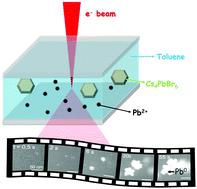Our official English website, www.x-mol.net, welcomes your
feedback! (Note: you will need to create a separate account there.)
Detection of Pb2+ traces in dispersion of Cs4PbBr6 nanocrystals by in situ liquid cell transmission electron microscopy
Nanoscale ( IF 5.8 ) Pub Date : 2021-1-18 , DOI: 10.1039/d0nr08584g Zhiya Dang 1, 2, 3, 4 , Liberato Manna 5, 6, 7, 8 , Dmitry Baranov 5, 6, 7, 8
Nanoscale ( IF 5.8 ) Pub Date : 2021-1-18 , DOI: 10.1039/d0nr08584g Zhiya Dang 1, 2, 3, 4 , Liberato Manna 5, 6, 7, 8 , Dmitry Baranov 5, 6, 7, 8
Affiliation

|
The Cs4PbBr6 nanocrystals are often used as a starting material for the preparation of green-emitting CsPbBr3 perovskite nanocrystals by means of chemical and physical transformations. Herein, we probe the Cs4PbBr6 nanocrystals dispersed in a solvent by liquid cell transmission electron microscopy (LCTEM). The nanocrystal dispersion in toluene is placed between two electron-transparent membranes separated by a gold spacer in a liquid cell and studied in a high angular annular dark-field scanning TEM mode with a fixed electron dose rate. We observe the spontaneous nucleation and growth of round and dendrite-shaped nanoparticles under electron beam illumination in the areas of solution where no Cs4PbBr6 nanocrystals are seen. These newly-formed nanoparticles show high contrast and contain Pb as the only heavy element, suggesting that they are made from metallic lead and indicating Pb2+-containing species in solution as their precursor. Also, a small amount of Au0 nanoparticles are formed, most likely due to the dissolution of the gold spacer by free Br-containing species in the nanocrystal dispersion and a subsequent reduction of the leached species under the electron beam. The analysis of the UV-Vis absorption spectra of Cs4PbBr6 nanocrystals and the supernatant isolated from the synthesis points to mixed lead(II) oleate/bromide species as the likely residue, corroborating LCTEM results. The identification of the residual precursors in Cs4PbBr6 nanocrystal samples after the post-synthetic isolation is an important task because the residues may alter the subsequent reactivity of the nanocrystals.
中文翻译:

原位液体细胞透射电镜检测Cs4PbBr6纳米晶体分散体中的Pb2 +痕迹
Cs 4 PbBr 6纳米晶体通常用作通过化学和物理转化制备绿色发光的CsPbBr 3钙钛矿纳米晶体的原料。在本文中,我们通过液体细胞透射电子显微镜(LCTEM)探测了分散在溶剂中的Cs 4 PbBr 6纳米晶体。将甲苯中的纳米晶体分散体放置在两个由金间隔物隔开的电子透明膜之间,该两个电子透明膜位于液池中,并在高角环形暗场扫描TEM模式下以固定的电子剂量率进行研究。我们观察到在没有Cs的溶液区域中,电子束照射下圆形和枝状纳米颗粒的自发形核和生长。可以看到4 PbBr 6纳米晶体。这些新形成的纳米粒子显示出高对比度,并含有Pb作为唯一的重元素,这表明它们是由金属铅制成的,并表明溶液中的Pb 2+物种为其前体。而且,形成了少量的Au 0纳米颗粒,这很可能是由于金间隔物被纳米晶体分散体中的游离含Br物质溶解,以及随后电子束下浸出物质的减少所致。Cs 4 PbBr 6纳米晶体的UV-Vis吸收光谱及从合成点分离出混合铅的上清液的分析( II)油酸盐/溴化物物质可能残留,证实了LCTEM结果。在合成后分离之后,鉴定Cs 4 PbBr 6纳米晶体样品中的残留前体是一项重要任务,因为残留物可能会改变纳米晶体的后续反应性。
更新日期:2021-01-18
中文翻译:

原位液体细胞透射电镜检测Cs4PbBr6纳米晶体分散体中的Pb2 +痕迹
Cs 4 PbBr 6纳米晶体通常用作通过化学和物理转化制备绿色发光的CsPbBr 3钙钛矿纳米晶体的原料。在本文中,我们通过液体细胞透射电子显微镜(LCTEM)探测了分散在溶剂中的Cs 4 PbBr 6纳米晶体。将甲苯中的纳米晶体分散体放置在两个由金间隔物隔开的电子透明膜之间,该两个电子透明膜位于液池中,并在高角环形暗场扫描TEM模式下以固定的电子剂量率进行研究。我们观察到在没有Cs的溶液区域中,电子束照射下圆形和枝状纳米颗粒的自发形核和生长。可以看到4 PbBr 6纳米晶体。这些新形成的纳米粒子显示出高对比度,并含有Pb作为唯一的重元素,这表明它们是由金属铅制成的,并表明溶液中的Pb 2+物种为其前体。而且,形成了少量的Au 0纳米颗粒,这很可能是由于金间隔物被纳米晶体分散体中的游离含Br物质溶解,以及随后电子束下浸出物质的减少所致。Cs 4 PbBr 6纳米晶体的UV-Vis吸收光谱及从合成点分离出混合铅的上清液的分析( II)油酸盐/溴化物物质可能残留,证实了LCTEM结果。在合成后分离之后,鉴定Cs 4 PbBr 6纳米晶体样品中的残留前体是一项重要任务,因为残留物可能会改变纳米晶体的后续反应性。











































 京公网安备 11010802027423号
京公网安备 11010802027423号